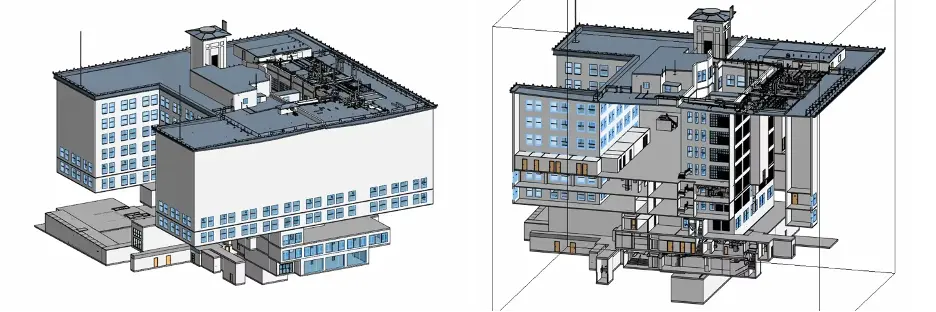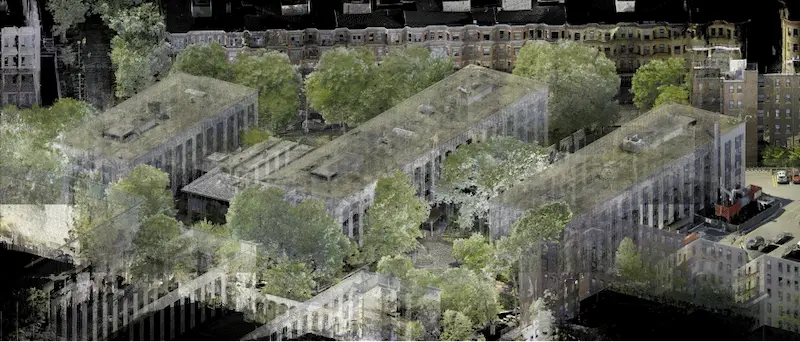What Architects Need to Know About Adaptive Reuse

Every adaptive reuse project starts with a puzzle, and not the kind with a picture on the box. This puzzle is missing pieces, has no instructions, and half the image is buried behind concrete walls or hidden under decades of renovations. That means if you aren’t already filling in the missing pieces of adaptive reuse puzzles for your clients, you may be losing valuable design opportunities. Here are a few of Existing Conditions’ recommended best practices to help you fill in the blanks.
According to the American Institute of Architects, retrofitting, renovating, adapting, and remodeling existing structures now comprise nearly 50% of all architectural billings in the United States, reflecting a significant shift in industry priorities toward the reuse and optimization of the built environment instead of building anew.
Before architects can reimagine a space, they need to uncover what’s there: where the utilities run, how the structure holds up, what’s safe to move, and what absolutely isn’t. Technologies like reality capture, concrete scanning, utility locating, and video pipe inspection help fill in the blanks – turning guesswork into reliable information and old buildings into new opportunities.

How to Use Reality Capture in Adaptive Reuse Projects
How Reality Capture Helps Preserve or Renovate the Envelope
Utilizing advanced reality capture technologies is critical for adaptive reuse projects. When a building’s façade is deteriorating due to corrosion or structural failure, 3D laser scanning provides a non-invasive method to document and preserve its architectural features – and it does not cause damage to the building’s elements.
This technology captures intricate details with construction-grade accuracy, generating accurate digital representation in various data outputs: 3D Revit models, 2D CAD drawings, virtual site visits, 3D meshes…and the list goes on. Since historical documentation and old as-built drawings are often outdated or unreliable, reality capture data provides architects with the information they need to focus on their designs.
“The extensive data that Existing Conditions gathered allowed us to collaboratively create a highly accurate digital model of the Little Building façade circa 1917, which was no easy task given the complexity of the highly ornate neo-gothic architecture. The ability to communicate the model data directly to the fabricator enabled us to have complete control over the outcome of the replicated façade elements" – Ross Cameron, Vice President of Elkus Manfredi Architects
RELATED ARTICLE: Read more about The Little Building’s Adaptive Reuse project, spanning ten years.
But, what about what’s within?
Mapping Structural Layouts for Adaptive Reuse
How Reality Capture Visualizes Missing Pieces in Interior Spaces
In adaptive reuse projects involving mid-century concrete structures, like the Hotel Marcel (originally a Brutalist office building), having situational awareness of the existing structural system is essential. These buildings typically feature precast concrete panels reinforced with rebar or wire mesh and often include post-tensioned (PT) concrete slabs. The architectural layout is generally consistent: a reinforced concrete and glass envelope surrounding a central core of elevator shafts, with large open floor plates, perimeter offices, and centralized restrooms. Beneath layers of finishes, wood, insulation, carpet lie critical structural and MEP systems that must be accurately documented before any design intervention.
Repurposing such buildings into new uses, particularly those with sustainability goals, requires detailed knowledge of existing conditions. Original as-built drawings, if available, are frequently outdated or incomplete. For architects, this makes early-stage documentation a priority.
Capturing interior spaces, especially those that are difficult to access or unsafe for manual measurement is essential. Technologies like 3D laser scanning and photogrammetry allow project teams to safely and accurately document these areas, ensuring a comprehensive understanding of interior layouts. This is particularly important for calculating usable square footage, planning circulation, and coordinating MEP systems.
In PT concrete structures, this involves combining concrete scanning and imaging with 3D laser scanning and photogrammetry. These technologies enable millimeter-accurate mapping of PT cable drape, rebar layout, embedded conduit, HVAC systems, and plumbing infrastructure. Without this data, the design team, including architects, engineers, and contractors, risks proceeding without a reliable spatial or structural baseline.
.webp)
This is particularly critical in PT slabs, where striking a cable or conduit during coring or cutting can result in structural damage, safety incidents, and repair costs exceeding $30,000 per occurrence.
When concrete scans and reality capture are used in concert, it can render a highly accurate picture of the infrastructure hidden in and behind the walls, to avoid clashes and rework. For architects leading adaptive reuse efforts, integrating verified subsurface and structural data into the design process is not optional, it is foundational to risk mitigation, code compliance, and successful project delivery.
How Buildings Are Evaluated Before Adaptive Reuse Renovations
Before initiating an adaptive reuse renovation, a developer typically partners with an architect with relevant project experience including tenant improvements or full-scale redevelopment.
The architect is responsible for evaluating the building’s existing conditions to determine its suitability for the intended new use.
This assessment ensures the structure can be safely and effectively adapted. The architect conducts a detailed review of the building’s physical state, code compliance, and design potential.
Skipping this step may reduce upfront costs, but according to Utilities One Engineering Inspections, it can result in unforeseen expenses and safety risks if structural deficiencies go undetected.
A standard assessment includes structural analysis to identify required reinforcements or alterations, verification of compliance with current building codes and accessibility standards, including ADA, review of zoning regulations and any historic preservation constraints, and evaluation of existing mechanical, electrical, and plumbing (MEP) systems to determine upgrade or replacement needs.
Following the assessment, the architect will proceed with renovation planning, material specifications, and construction oversight.
Adaptive reuse projects require close coordination among architects, engineers, contractors, and developers to ensure that all design and regulatory requirements are met within the constraints of the existing structure.
How Architects Use Existing Conditions to Plan Renovations
In most adaptive reuse projects, original construction documents are either missing or incomplete. To address this, architects typically select a reality capture service provider like Existing Conditions to perform a 3D laser scan of the building or structure. This process produces accurate as-built data, which is critical for developing reliable design models and reducing the risk of unforeseen conditions during renovation.
Existing Conditions uses cutting-edge 3D laser scanning equipment to capture high-resolution spatial data of all visible building elements, including walls, windows, structural systems, and MEP infrastructure. The resulting point cloud serves as the foundation for Building Information Modeling (BIM), allowing architects to work from accurate as-built documentation rather than relying on traditional measurement methods.
The point cloud is then converted by the Existing Conditions Mapping & Modeling Team into a BIM model, which digitally represents the building’s geometry and systems. BIM supports early-stage design exploration, spatial coordination, and refining renovation strategies based on actual site conditions.
With accurate existing conditions modeled in BIM, architects can evaluate which components can be retained and which require replacement, including roofs, walls, windows, and interior partitions. The model also supports the development of detailed construction documents, including structural layouts, MEP coordination, material specifications, and finish schedules.
Floor plans and virtual walkthroughs can be generated to communicate design intent and support stakeholder engagement. BIM further enables coordination with VDC teams and contractors, helping reduce errors, improve safety, and enhance overall project efficiency.
RELATED ARTICLE: Why Virtual Design and Construction Matters in AEC
Capturing Existing Conditions for Adaptive Reuse of a Historic Hotel
Existing Conditions was selected to perform 3D laser scanning services to support the architectural design of a historic building renovation in Philadelphia, which involved converting the 250,000-square-foot structure into a luxury hotel. The architect required highly detailed documentation of walls, ceilings, floors, staircases, balustrades, and colonnades, as well as exposed structural elements like beams and columns.
The Project Managers scanned the entire building, including the exterior façade, basement, mechanical spaces, roof, penthouses, and floors 1-4. Based on the architect’s specifications, a 3D Revit model was developed using a combination of LOD 200 and LOD 300 detail levels to support design accuracy and coordination.
“The point cloud and 3D model worked out tremendously well. This was almost the perfect project to use it on due to the various intricacies of the building layout and large differences from floor to floor.” – N. Pellizzari, Architecture & Planning Professional
.webp)
How Existing Conditions Supports Adaptive Reuse Projects
Existing Conditions provides architects with accurate 3D laser scanning and BIM modeling services to support adaptive reuse and retrofit design.
These tools and deliverables allow design teams to explore different layout options, test functional improvements, and evaluate sustainability strategies in a virtual environment before construction begins.
Highly trained Project Managers from Existing Conditions use advanced laser scanning equipment to capture highly accurate measurements and spatial data from the project site. This ensures that every visible architectural and structural element is documented with precision, including walls, ceilings, floors, staircases, and MEP systems.
The Mapping & Modeling team at Existing Conditions processes this data into detailed point clouds, 2D CAD drawings, and 3D BIM models. These deliverables improve coordination among your project team by providing a shared, accurate reference for design and construction planning.
With decades of experience and a national presence, Existing Conditions measures approximately 50 million square feet annually and delivers reliable as-built documentation that helps reduce project risks, avoid change orders, and control costs for your projects. Existing Conditions’ services give your project teams the confidence to move forward with complex renovations based on verified existing conditions, ensuring reliable decision-making from concept through construction.
Over the past 27 years, Existing Conditions has measured, documented, and modeled over 10,000 buildings spanning over 700 million square feet across the United States, establishing ourselves as an industry leader in 3D laser scanning. Architects, builders, engineers, developers, and facility managers, trust us to deliver digital representations of the as-built environment with unparalleled accuracy and efficiency. Our services, including 3D laser scanning, 3D photogrammetry, and BIM modeling, Intelligently Visualize The Built World® to enable architects to make informed design decisions based on the most accurate data available.
FAQs
What are the Benefits of 3D Laser Scanning?
.svg)
3D laser scanning captures millions of 3D data points per second for each scan location, providing incredibly rich data of a building or project site. Sites are captured in high detail the first time, eliminating disruption and the need for return visits. Datasets are dimensionally accurate, measurable and shareable, expediting project planning and execution. Accurate design plans are produced from the start expediting field work and reducing change orders, delays and costs. Communication is improved, teams can discuss plans while each has access to the same information, creating a more dynamic working environment.
How Can Existing Conditions Support My Project's Success?
.svg)
By choosing Existing Conditions as your as-built survey company, you're partnering with a team of experienced professionals. Understanding building language is important when working with architects, builders, engineers, and facility managers. We have professionals trained by architects and commercial real estate investors on our staff, so we can speak the language and deliver what is needed to advance the project. Our track record speaks for itself, partnering with top professionals in the building industry, including Gensler, Studio Troika, Shawmut Construction, the New York Stock Exchange, Williams College, and Harvard University.
How Does Scan to BIM Aid Renovations?
.svg)
Scan to BIM plays a critical role in renovations by providing accurate as-built data, point clouds, drawings and models that reflect the current state of a building. This ensures that renovation plans are based on precise data, minimizing the risk of costly errors and ensuring seamless integration with existing structures.










